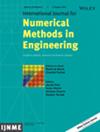磁活性弹性体中包含-矩阵相互作用的有限界面元
IF 2.7
3区 工程技术
Q1 ENGINEERING, MULTIDISCIPLINARY
International Journal for Numerical Methods in Engineering
Pub Date : 2024-12-16
DOI:10.1002/nme.7625
引用次数: 0
摘要
磁活性弹性体(MAEs)是一种新兴的智能复合材料,由柔性弹性体基体填充刚性,可磁化的内含物组成。将基体和夹杂物视为离散的中观尺度模型目前是在假设界面完美结合的情况下建立的。本文建立了材料界面内聚损伤模型,并介绍了磁场在材料界面内传输的处理方法。举例说明的概念和结构响应的差异,样品处理与传统的和提出的方法。本文章由计算机程序翻译,如有差异,请以英文原文为准。

A Finite Interface Element for Modeling Inclusion-Matrix Interaction in Magneto-Active Elastomers
Magneto-active elastomers (MAEs) are an emerging smart composite material consisting of a compliant elastomer matrix filled with stiff, magnetizable inclusions. Meso-scale models, which treat the matrix and inclusions as discrete, are currently formulated with the assumption of perfect bonding at the interface. We apply a model for cohesive damage at the material interface and introduce a treatment for the transmission of the magnetic field in the gap. Examples demonstrate the concept and the difference in structural response between samples treated with the conventional and presented approaches.
求助全文
通过发布文献求助,成功后即可免费获取论文全文。
去求助
来源期刊
CiteScore
5.70
自引率
6.90%
发文量
276
审稿时长
5.3 months
期刊介绍:
The International Journal for Numerical Methods in Engineering publishes original papers describing significant, novel developments in numerical methods that are applicable to engineering problems.
The Journal is known for welcoming contributions in a wide range of areas in computational engineering, including computational issues in model reduction, uncertainty quantification, verification and validation, inverse analysis and stochastic methods, optimisation, element technology, solution techniques and parallel computing, damage and fracture, mechanics at micro and nano-scales, low-speed fluid dynamics, fluid-structure interaction, electromagnetics, coupled diffusion phenomena, and error estimation and mesh generation. It is emphasized that this is by no means an exhaustive list, and particularly papers on multi-scale, multi-physics or multi-disciplinary problems, and on new, emerging topics are welcome.

 求助内容:
求助内容: 应助结果提醒方式:
应助结果提醒方式:


